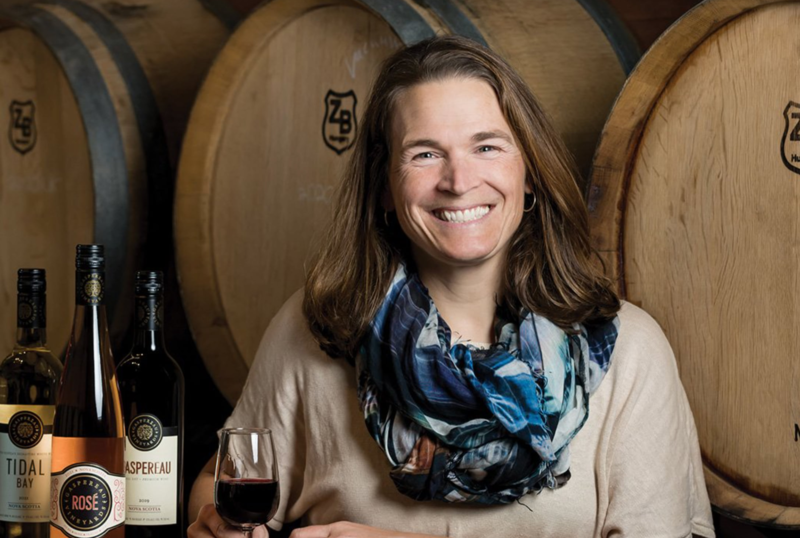The Evolution of Nova Scotia Wine with Gina Haverstock. By Lola Augustine Brown

Published: Thursday, June 29, 2023
In the summer of 2000, Gina Haverstock had just finished a degree in biochemistry. She was headed to medical school and needed somewhere distraction-free to study for entrance exams, so she went to her family cottage in Malagash. While there, she took a summer job at Jost Vineyards that would completely change her trajectory.
Before starting at Jost, Haverstock had limited exposure to wine—a glass of Baby Duck at her family Christmas dinner. That summer, she fell in love with everything about wine, marvelling at how you could taste so much about the terroir in each bottle and savouring the tasting sessions that Hans Christian Jost would run to educate his team. Haverstock never did take those med school exams. Instead, she stayed on at Jost for a year, then went back to school to study viticulture and enology at Brock University, hoping that she'd find a job here at home after graduating.
Happily, after Haverstock completed her studies in 2006, Hans Christian and Karen Jost offered her the job of head Winemaker at Gaspereau Vineyards, which they’d opened just two years earlier. “I’d concentrated my studies on growing grapes in cool climates, doing work terms in places that were somewhat reflective of what I’d find in Nova Scotia—I did a year and a quarter in Germany as part of my degree, but I also worked in New Zealand, Burgundy, and Austria,” she says, “At that time the wine industry here was so small that I didn’t know I’d be able to work here. Hans Christian and Karen expanding into the Annapolis Valley worked out well for me, and I was able to bring all the techniques I had learned home.”
Haverstock’s status as a winemaker grew, with somebody christening her the “Reisling Princess.” Back then, Nova Scotian wines were quite a novelty; although they had already started winning awards, they in no way commanded the attention they do now.
Over the past 20-plus years, Haverstock watched the industry she loves blossom and grow. Though loathe to take much credit, she is undoubtedly owed it, with a raft of awards and recognition well earned in her time in the industry. “These days, I’m more the Reisling Queen, or, maybe, I’m even the Queen Mother at this point,” she quips. Since 2018, Haverstock has held the position of head winemaker at Devonian Coast Wineries—made up of Jost, Gaspereau and Mercator Vineyards, by then under the ownership of Carl and Donna Sparkes. We asked Haverstock to share how our wine industry has evolved and what’s next.
How it started
The first winery to open in the province was Domaine de Grand Pré in 1979, followed soon after by Jost. The wines were decent, winning awards and garnering some acclaim, but it was a couple of decades before the Nova Scotia wine industry would find its feet. Haverstock returned to the province as one of only a handful of winemakers here just as the industry was on the verge of becoming the success story it is today.
Haverstock's wines started winning awards within a year of taking the helm at Gaspereau. Over the years since Haverstock’s wines have won far too many to list but include 9 of the 31 Lieutenant Governor’s Awards for Excellence in Nova Scotia Wine. “Awards are important; they give the consumer confidence. They know that some third party says this wine is good,” she says. She adds that she enjoys the validation but doesn’t get too excited about awards and concentrates on the big picture instead. What did excite Haverstock immensely was early career recognition from long-time Globe and Mail wine columnist Beppi Crosariol.
“We’d won a silver or gold award at a national competition, and it was the first time that a riesling from Nova Scotia had won an award, and Beppi wrote in his column that we had put Nova Scotia on the wine map,” Haverstock explains, “That really hit home for me.”
(Ever humble, Haverstock is downplaying what Crosariol said: “It has taken a quarter century of pioneering vision and tenacity by a group of mavericks to forge a fledgling wine industry in Nova Scotia. It took one woman, Gina Haverstock, less than a year to put it on the map.”)
That is not to say that other Nova Scotia wines and wineries were not also making their mark. More wineries opened, and brilliant winemakers landed here, tempted by the fact that something fresh and exciting was kicking off. Jean-Benoît Deslauriers was one of those winemakers. He came from Quebec to work at Benjamin Bridge, and his first vintage was the runaway hit sparkling white Nova 7 (launched in 2007, hence the name). Nova 7 was so different from any other wine in Canada, showing that our microclimate offered a unique terroir. And it caught on, leading to Nova Scotia developing a protected geographical appellation.
The Tidal Bay Effect
Haverstock says introducing the Tidal Bay appellation in June 2012 was pivotal for the Nova Scotia wine industry. “Once you have an appellation, a standardized wine that has to be approved by an independent third party with strict standards, it gives people confidence; They know it’s going to be good,” Haverstock explains, adding that winemakers—herself included—tend to get bogged down in the details about varieties and the nitty gritty of wines, whereas having Tidal Bay allows them to talk about the taste and terroir of the province, and why we grow grapes so well here, in one sentence. “It’s like, this is a taste of Nova Scotia in a glass,” she says.
For wines to be part of the appellation, the grapes used must be grown here and pass annual blind tasting tests to ensure they are still delivering the crisp, dryish, aromatic flavour profile unique to Nova Scotia. These wines pair brilliantly with the foods grown and raised here, “Which is something that happens naturally in other wine regions,” remarks Haverstock.
Marketing-wise, Tidal Bay was brilliant. “You don’t have to talk about all these different varieties of grape that people have never heard of, you can talk about several wineries in one breath, and it’s such an easy way to spread the word,” Haverstock says. “You may prefer one Tidal Bay over another, but it would be highly unlikely that you would love one Tidal Bay and despise another. There’s a commonality in all the Tidal Bays; it gave consumers the confidence to try bottles from other wineries because they know the style.” There are now 14 wineries in Nova Scotia with wines qualified to bear the Tidal Bay name.
The knock-on effect of having an NS appellation was that it opened people up to trying the other—non-crisp sparkling white—wines produced here. “It was our entry wine,” Haverstock says, “Once people tried Tidal Bay, they understood Nova Scotian wine and what our terroir was all about.” And so the industry grew, more wineries, more awards, and the planting of different varietals that our warming climate was suddenly making possible.
Storms on the horizon
When asked about the future of our industry, the effects that climate change is having—and will have—are top of mind for Haverstock. “I always explain that it isn’t for the better. People assume that warmer weather is good because we can grow grapes that we couldn’t here before. That’s absolutely true, but it’s reaching a point where the uncertainty of the weather systems is making it much harder for us,” Haverstock says. “We used to know that we’d start harvest after Thanksgiving, but now we are starting earlier and earlier to make sure we are able to maintain that acidity we need.”
Then, of course, there is the impact of the weather systems that are causing intense storms to land at an alarmingly increasing rate. When we spoke, the post-tropical storm Fiona had just caused havoc to Haverstock’s vineyards. “There are other considerations than temperature and heat units,” Haverstock says, “The instability of the weather is a major concern.”
Losing power for a week at harvest time meant they had to work out how to run their crush equipment, lights, cooling systems etc., on generators. “That really limited how quickly we could get the fruit in after Fiona, and we lost fruit too because it blew off the vines, and where it was so warm, it was apt to start breaking down and rot, so we had to get to it quickly. We were able to salvage some of that, but not as much as we wanted to because without power we no longer had the cooling capacity.”
At this year’s harvest wrap-up, the Devonian Coast Wineries team strategized about how they could have everything hooked up with just one switch to a generator. “And we were not talking about if but when we lose power again,” Haverstock says, “What’s happening with the climate changes everything for us.” Still, Haverstock and the team move forward, working hard to produce the wonderful wines they are known for.
Goals and aspirations
There are now more than 20 wineries in Nova Scotia, ranging from larger-scale operators to smaller boutique wineries. The economic impact that the industry has on our province is huge: Wine Growers Nova Scotia states that the sector contributes more than $245.2 million annually. Wine creates employment and opportunity in areas that have been economically depressed for decades, breathing new life into small towns and forming dots on the map.
Beyond the vine-to-bottle production of wine, the industry has been a massive driver of tourism to the province. Wine Growers Nova Scotia data from 2019 stated that the wine industry attracted more than 150,000 visitors to Nova Scotia, which will only increase. Our wineries are often architecturally beautiful or set in historic properties, offering fantastic dining experiences and the signature warm welcome that brings visitors back year after year. Nova Scotia has a wine industry to be proud of.
Haverstock thinks there is still plenty of room for our wine industry to grow and loves the community that blossomed as it expanded. Winemakers here help each other out, she says and admits that as they’ve all got older and had kids, the community doesn’t get together as often as they used to, but they’ve still got each other's backs.
Talking to Haverstock, it's clear she’s still just as in love with the wine industry here as when she took that summer job at Jost. “Oh yes,” she says, “I have no regret about not making it to med school; I love what I do.”
Over the years, the joy that comes from Haverstock seeing her wines enjoyed has never diminished, which drives her. “I’m not the type to tell people in a restaurant that I made the wine that they are drinking, but when I hear a server describing the wine in great detail and getting it right, I feel a rush of pleasure,” Haverstock says, “ I love seeing people enjoying our wines, it’s the best.”


